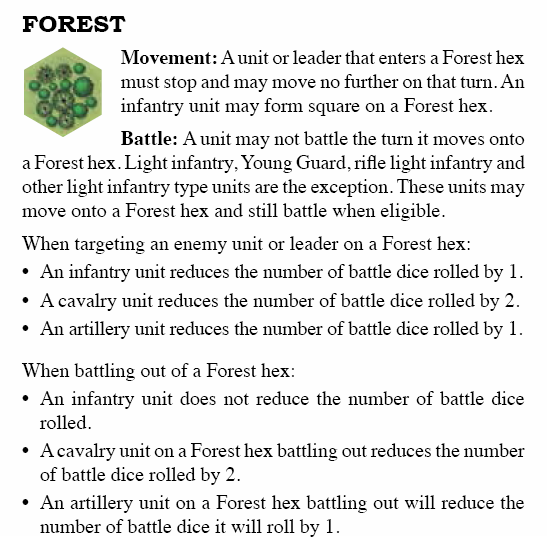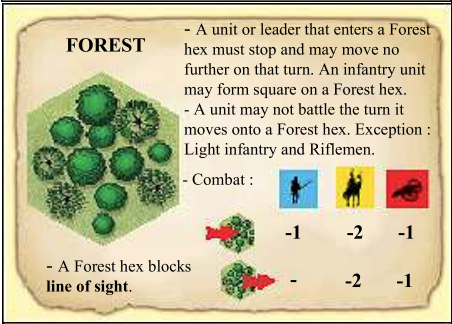Commands & Colors Napoleonics
INITIATION - KIT
to be used as a memento by an experimented player teaching beginner(s).
These are the very basis of the system to explain before a game with a beginner (or teaching two beginners). This allow to quickly start the game and of course, the different actions will need more detailled explanations during the game, case by case. With basic cards reference for Terrain & Units, plus a Scenario “special for beginner”...
The battlefield game board has three sections by two dotted lines : where the dotted line cuts through a hex, the hex is considered to be part of both sections.
Units and Leaders
Each unit is composed of several blocks. A leader is represented by one block.Two units may never occupy the same hex.Two leaders may not occupy the same hex. A leader in the same hex as a friendly unit is considered “attached” to the unit and must move along with the unit unless the leader is ordered to detach. The three main types of units are : infantry, cavalry and artillery.
The object of the game
The main object is to be the first to capture a set number of Victory Banners gained for each enemy leader or enemy unit entirely eliminated.
Sequence of Play
- COMMAND phase: Play a Command card.
- ORDER phase: Announce all units and leaders you intend to order, within the limits of the Command card just played.
- MOVEMENT phase: Move all ordered units and leaders, one at a time (it only costs one command to order a unit and its attached leader to move and/or battle together). A unit or leader may only be ordered to move once per turn. A unit or leader that is ordered does not have to move.
- COMBAT phase: Battle one ordered unit at a time and each unit’s combat must be fought to completion including any additional combat actions before another combat.A unit that is ordered does not have to battle.You may switch between ranged combat and melee combat from one unit to the next.
- DRAW phase: Draw a new Command card.
Ranged Combat
Only infantry and artillery units may engage in ranged combat. The target unit must be within both range and line of sight. A unit adjacent to an enemy unit may not fire on another, more distant, enemy unit.The line of sight is blocked only if a hex between the battling unit and the target contains an obstruction.
Number of battle dice rolled in ranged combat when the infantry unit does not move is equal to the number of blocks in the infantry unit. When an infantry unit moves, the base number of battle dice rolled is equal to 1/2 the number of blocks in the unit, rounding up or down (depends on nationality). An ordered horse artillery unit, which does not move, may target an enemy unit 4 or fewer hexes. In ranged combat, the attacker scores 1 hit for eachtroop symbol rolled that matches the target unit.
Melee Combat
A unit attacking an adjacent enemy unit is said to be engaging that enemy unit in melee. In melee combat, the base number of battle dice rolled is equal to the number of blocks in the unit, even if the infantry unit has moved prior to the melee combat.
A horse artillery unit normally rolls 3 dice in melee.
In melee combat, the attacker scores 1 hit for each troop symbol rolled that matches the target unit and 1 hit for each sabers.
Retreats
A flag does not cause a hit, but may cause the unit to retreat. For each retreat flag rolled against a unit, the unit must move one hex back toward its own side of the battlefield.one block must be removed from the unit for each retreat hex of move that cannot be completed.(Both for ranged or melee combats).
Leaders
A leader alone in a hex may not be targeted in ranged combat but an unattached leader may be attacked in melee. When a leader is alone in a hex, the attacking enemy unit rolls its normal melee battle dice. One or more saber symbols rolled will score a hit and eliminate the leader. Leaders may move up to 3 hexes.
When a leader is attached to a unit and the unit loses at least one or blocks, or is eliminated, there is a chance that the leader may also be hit. Make a leader casualty check by rolling 2 battle dice. To hit the leader two saber symbols must be rolled. (When the unit is eliminated, the leader casualty check is made with 1 battle dice and a saber symbol must be rolled). If the leader is not hit, the leader must retreat 1, 2, or 3 hexes.
Morale
A unit may disregard one flag when a leader is attached to the unit and when supported by two or more friendly units on any hexes that are adjacent to the unit.
Battle Back
In a melee combat, the defending enemy unit may Battle Back against the attacking unit if one or more of the defending unit’s blocks survived the melee combat attack and the defending unit did not retreat from its hex.
Infantry Taking Ground in melee combat
A victorious attacking infantry unit may advance onto the vacated hex when the defending enemy unit/leader is eliminated or retreat. A square or an Artillery unit may not Take Ground.
Cavalry Breakthrough
A victorious attacking cavalry unit may advance onto the vacated hex, and after advancing onto the vacated hex, the cavalry unit may then move one additional hex. After a successful melee combat, a cavalry unit that makes a breakthrough is eligible to battle in melee combat a second time.
Cavalry Retire and Reform
When being attacked in melee by an enemy infantry unit, a cavalry unit may choose to Retire and Reform (2 hexes toward its own side of the battlefield) instead of fighting in the melee. The attacking infantry unit rolls the proper number of melee battle dice but only cavalry symbols will score a hit against a cavalry unit electing to Retire and Reform.
Infantry Forming Square
An infantry unit at any strength may choose to form square during the opponent’s turn before a cavalry unit is about to melee attack the infantry unit. If the infantry unit does not choose to form square, the cavalry melee attack is resolved normally.
Combined Arms Combat
When an ordered infantry or cavalry unit is about to attack an enemy unit in melee, one ordered artillery units may combine their battle dice with the attacking unit.
Inside this file you will also find detailed charts for both units and terrains.
Moreover you will find an introductory scenario PD02 Venta del Pozo (23 October 1812).
Enjoy playing.





